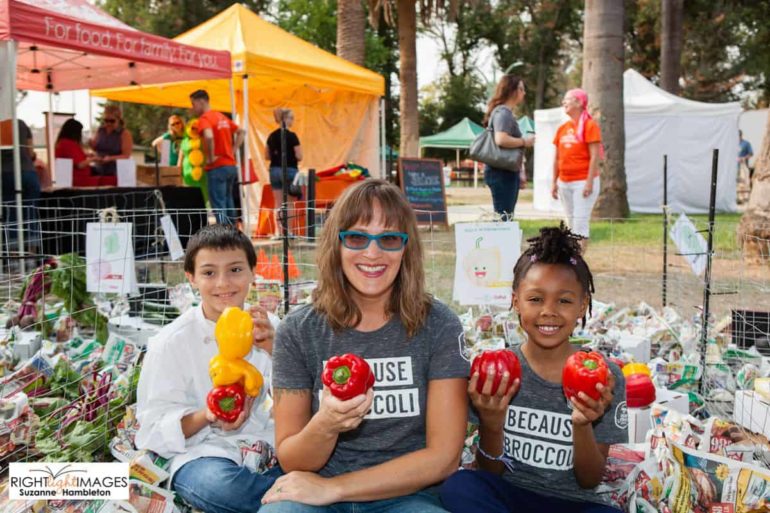The Food Literacy Center in Sacramento, California is a nonprofit organization teaching low-income elementary students about nutrition and food systems. Using positive reinforcement and enthusiastic, creative lessons, the Food Literacy Center inspires kids to eat more fruits and vegetables. Forty percent of Sacramento youth struggle with obesity and the Center is working through local non-profits and schools to teach kids how to make healthy food choices. The Center also hosts a Food Literacy Academy, which cultivates aspiring food geniuses to become leaders in the food literacy movement.
Founder and Chief Food Genius Amber Stott spoke with Food Tank about the Food Literacy Center’s approach to nutrition education and the status of the Food Literacy movement.
Food Tank (FT): What is the biggest barrier to better nutrition for children in Sacramento?
Amber Stott (AS): For Food Literacy Center, one barrier that we choose to focus on is the problem of behavior. In America, we have generations of folks who grew up on gross, canned vegetables that were boiled to oblivion. We’ve grown up in a culture that has a thing known as kid food – as if food for kids should be any different than food adults eat. When we have a population where only six percent of kids are eating their recommended daily vegetables, we need to zero in and make a change.
FT: Your curriculum is called “Your Sandwich can Save the World!” What is the Food Literacy Center’s approach nutrition education? How can sandwiches save the world?
AS: I worked in a lot of social service non-profits before I started Food Literacy Center. We do something in social services called positive reinforcement. Essentially, this is highlighting the successful things that people are already doing, rather than harping on them for what they’re not doing right and need to change. This is how we get buy-in when we’re talking about behavior change.
We start with something positive: What’s one thing that every kid in America has eaten, enjoys and knows how to make? A peanut butter sandwich. So the very first recipe our kids make is a peanut butter sandwich. We swap out the white bread for whole wheat bread, we swap out the peanut butter for sun butter (because of allergies), and we swap out the jelly for fresh fruit slices. These are big changes for kids, but they’re still going to end up with a recipe that looks, feels, and tastes fairly similar to that tried and true PB&J.
FT: What particular Food Literacy Center class or program are you most proud of? Why?
AS: We have so many good ones! We have a fun lesson called tres hermanas where we teach the kids the Spanish and English words for the three sisters – corn, beans, and squash – and we make a delicious tres hermanas salsa that kids love. We also have a lesson where kids learn about parts of a plant. They take sunflower seeds out of a dried sunflower head, plant the seeds and make fresh sun butter. My favorite thing is how we spice it up and make everything different from class to class.
FT: What makes your organization work? What could other nutrition education programs, teachers, and parents learn from you?
AS: The important thing about the field of food literacy is that it’s brand new. I think the program with the deepest roots is Alice Waters’ Edible Schoolyard Project. (Food Literacy Center staff) went through the Edible Schoolyard Academy, and the biggest takeaway I had was the openness: how willing they are to share all that they know with others. Sharing is something we try to embrace here locally as well because it’s critical to the success of the food literacy field as a whole.
We have something called the Food Literacy Academy, a training program for community members who apply and then go through a twenty-hour intensive training. They’re highly knowledgable after they complete this training, and they become certified food geniuses. They deliver our programs for us. That is a big piece of our success because we’re creating ownership in the community. The (graduates of the program) go out and get jobs all over the community. That’s critical because we end up having this elevated level of food literacy dialogue in multiple layers of the community in addition to having experts who are teaching our kids.
FT: What individual or societal changes could most effectively improve children’s food habits?
AS: What the Food Literacy Center is doing needs to happen simultaneously with food policy. I can tell a little story as an example of this: I was in the grocery store, and I saw a grandma and her grandkids in the candy aisle. The kids were just throwing anything and everything that they wanted into the cart. There was a two- or three-year-old and she threw in some sour patch kids. The grandma was pleading with the girl to put them back. She was telling her, “You don’t know what these are, you don’t know that you don’t want these.”
I think that’s the very crux of the problem: We are letting kids choose, and kids are not choosing– it’s advertising that is directed at kids (that is choosing for them). Until we have a society where the first and best choice for our kids is always the healthy one, we’re going to continue to have this problem of diet-related disease. We need food policy because we need environmental changes.
Behavior change has to be coupled with knowledge. It’s really important that all levels– from adults to kids– are receiving this type of food literacy education. We go out of our way to make everything fun and delicious. We want to add things to people’s lives rather than taking away. I think when we start to see it that way, we’ll have more and more people joining the movement.













